Last week, I shared with you this botched framing job of an embroidery project that was causing me a wee bit of worry.
So many of you chipped in with great advice – thank you so much! I decided to re-do the frame job myself, salvaging the material components (the frame, mat, glass) and re-doing all the labor components of the frame job.
In fact, I was dying to open the thing up, just to see how they approached the job in the first place.
So, today, I’ll show you part one of my fix – where I disassemble the frame, remove the embroidery, and get it ready to re-frame it. And then Friday, I’ll show you the methods and materials I use for mounting and re-framing the work.
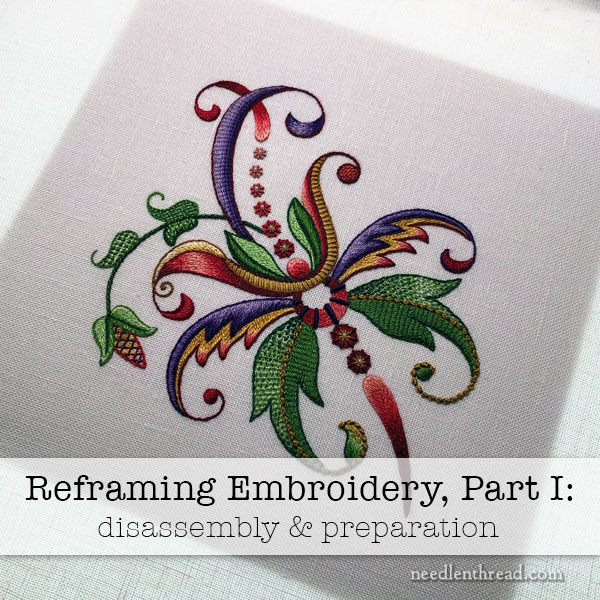
First, to answer a few questions that came up in the comments on last week’s article on the initial (botched) embroidery frame job.
No, I had never used these framers. I had inquired around locally, and they were recommended to me. I then researched them a little bit, checked out their reviews, and so forth. I was already familiar with the art gallery attached to the frame shop, and I liked it well enough. I spoke to them on the phone and asked about their experience with needlework. They said yes, they do a lot of needlework. So I went and talked to them in person.
The pertinent questions I asked were:
Will you trim and stretch the embroidery? The answer was yes.
How would it be stretched? The embroidery would be stretched and fixed to the mounting board (archival foam core) using some sort of plastic tabs (which she described).
Do you have museum glass? Yes, of course.
About how long could I expect the job to take? About two to three weeks, because the framer was injured and recovering.
I liked the people and atmosphere, and they were very confident and matter-of-fact about things. They saw the embroidery (in plastic and unfolded, so they could see the whole piece), and they had no questions for me or comments on any difficulties they might run into.
I also received no phone calls about the piece, until they called to say it was ready to pick up.
So that’s the complete backstory, which I hope answers the questions that many of you posed.
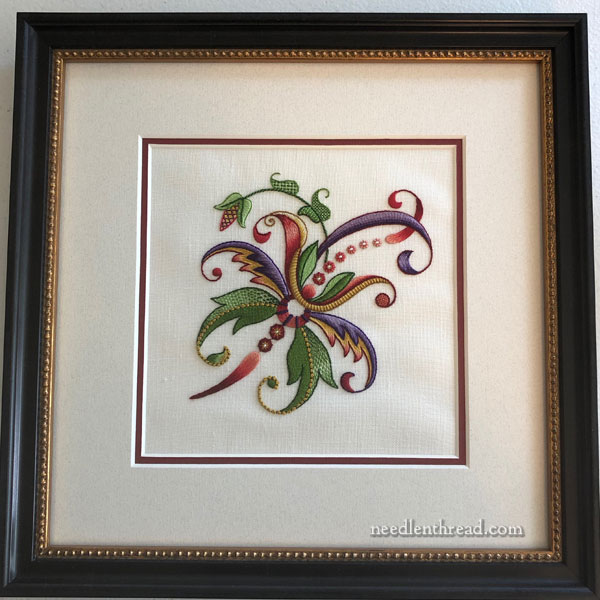
Next, I want to show you a head-on photo in regular lighting that I snapped for those who had the impression from the original photos that the ripples were not visible when looking straight at the image.
I adjusted the original head-on photo that you saw in the previous article and lightened it, to eliminate the shadows of the ripples, because I wanted folks to see the piece, framed, without the distraction of the ripples.
As you can see in the photo above, taken from the front and not adjusted in any way, the ripples were also noticeable from the front. You can see why I couldn’t really accept this – whether the framed piece was just for me, or for a gift, or for a book.
Over time, I had no doubt that the ripples would have become increasingly more problematic, too. And when I opened the back of the frame, this was confirmed.
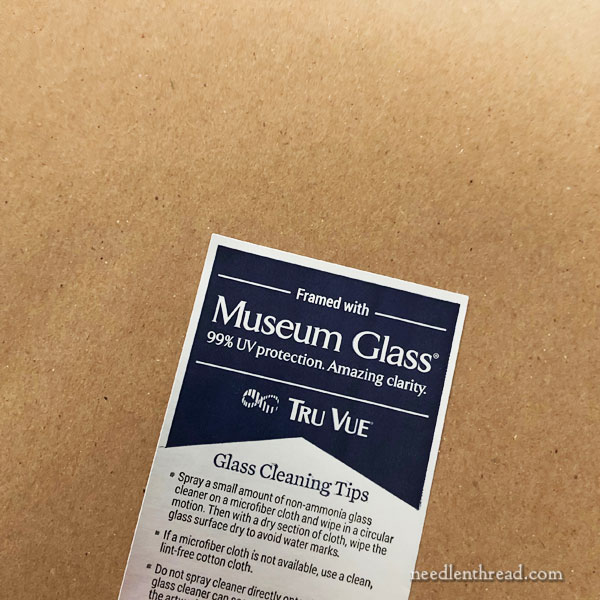
Approaching the back of the frame, there are the typical stickers – one indicating the use of museum glass, the other with the framing gallery information on it. The back is covered with brown paper, which is pasted in place.
I sliced the brown paper carefully around the inner area of the frame, using a craft knife.
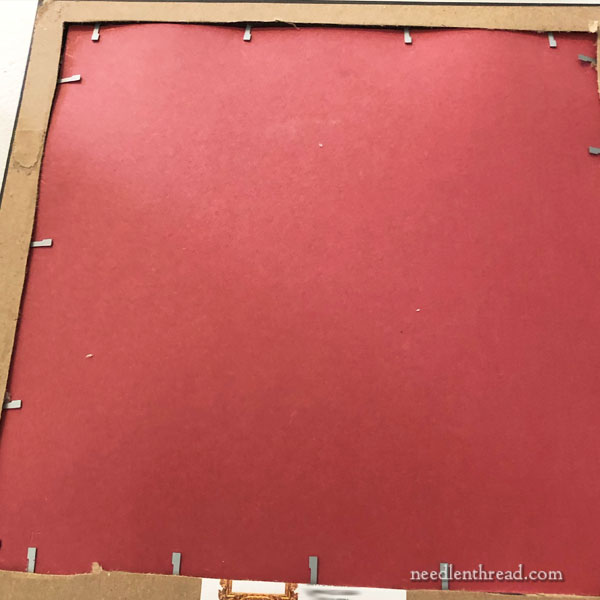
Behind the brown paper, I found red mat board held in place with rigid, flat framer’s points.
This is what I expected to find.
Only…. why was the mat board bulging so very much? It was really tightly held in place with the rigid points, and there was quite a bit of buckling going on.
Oh. My. Word.
I knew, right when I saw this, that there was no trimming, no stretching of the embroidery. I knew exactly what I would see when I removed the points and the mat board.
To remove the points, you can use a little tool that’s kind of a like a small nail remover tool, but you can also just grip the ends of them (with your fingers or with needle-nose pliers) and gently move them back and forth sideways a tiny bit, and they will slip out.
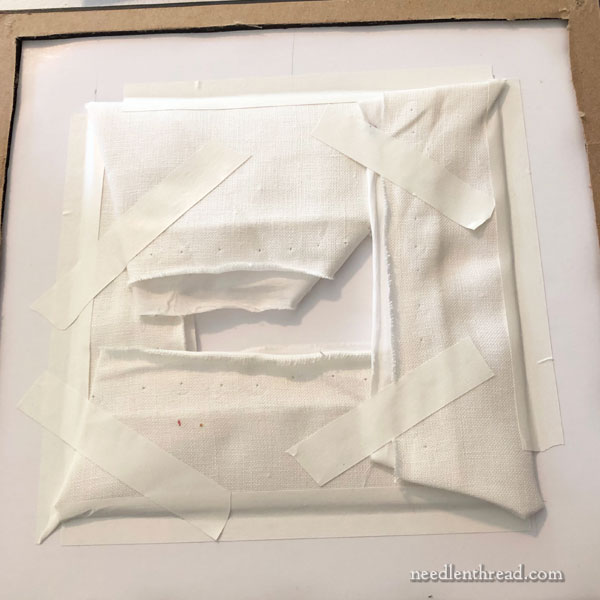
Sure enough, this is what I saw!
The embroidery was loosely folded around the foam core board used for mounting, stuffed into the hole in the foam core board that goes behind the decorative matting, and then loosely taped to hold the folds.
That’s it!
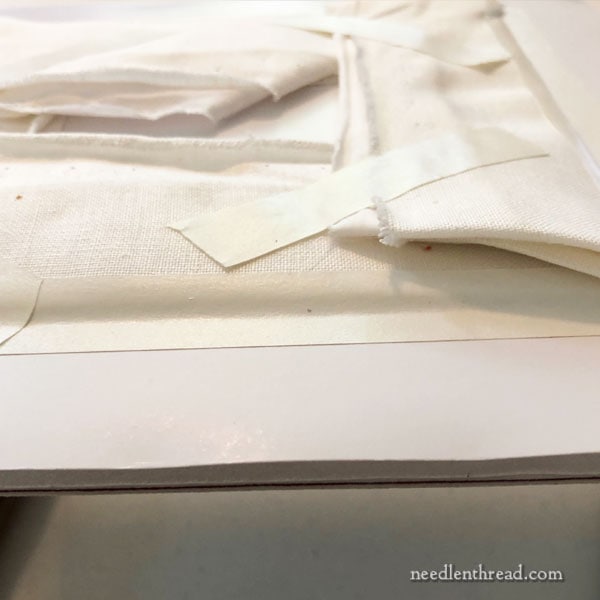
Look how thick and bulky that is.
Personally, I think some bells should have gone off in the framer’s head, maybe ringing along these lines:
“Surely this isn’t what the person had in mind – who would actually pay for someone to fold up a piece of fabric, tape it, and stuff it into a hole?”
“Maybe,” you’d think those bells would have peeled, “I should call her and discuss this with her.”
I had to chuckle. (Well, you might as well see humor in things, after all…)
No wonder the front was rippling. There was no tension on the fabric at all.
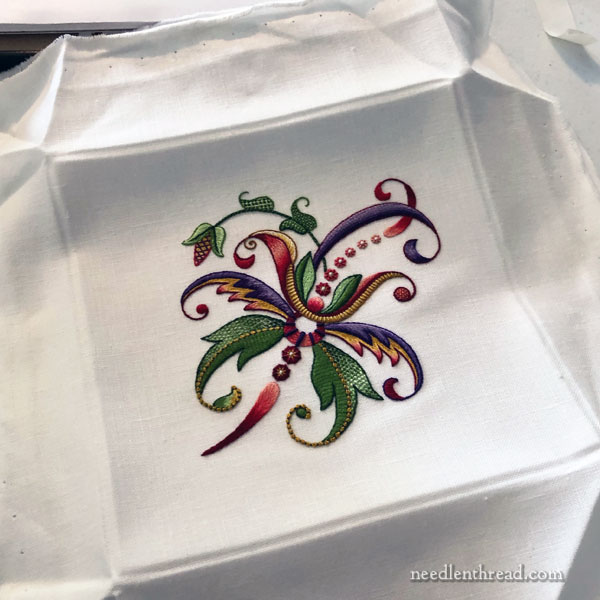
I removed all the tape, unfolded the fabric, and set about re-blocking it.
I needed to damp stretch it to get all the folds and marks from the foam core board out of it, since I needed to re-situate it on the board, and I didn’t want any of those creases to show on the front, if the fabric placement was different.
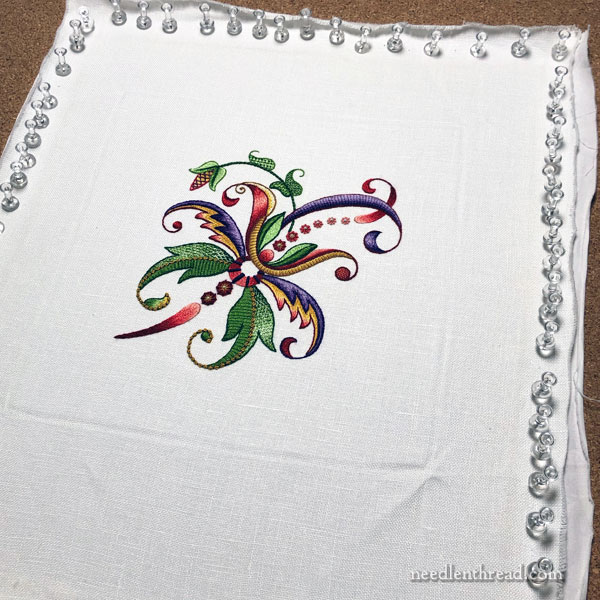
You’ll find instructions for damp stretching and blocking embroidery here.
Using push pins along the edge of the fabric, I squared up and pinned the fabric to a cork board, stretching it slightly as I went and making sure everything was ship-shape.
I misted the whole thing lightly with water. I usually use distilled water for this, and I use one of these spray bottles:
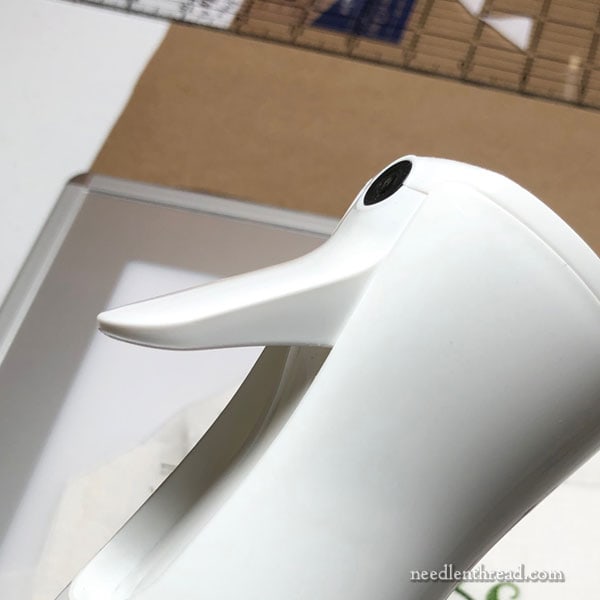
It’s a mister, rather than a sprayer, and it produces a really fine, light mist of water. I’ll add resources at the end of this article, where you can find the things I use for framing.
Anyway, the nice thing about a mister rather than a spritzer or sprayer is that you can lightly mist a piece of fabric even when it’s mounted on foam core board (you’ll see that in the next article), and the water isn’t going to be heavy enough to penetrate the fabric to the board. I love my mister bottle.
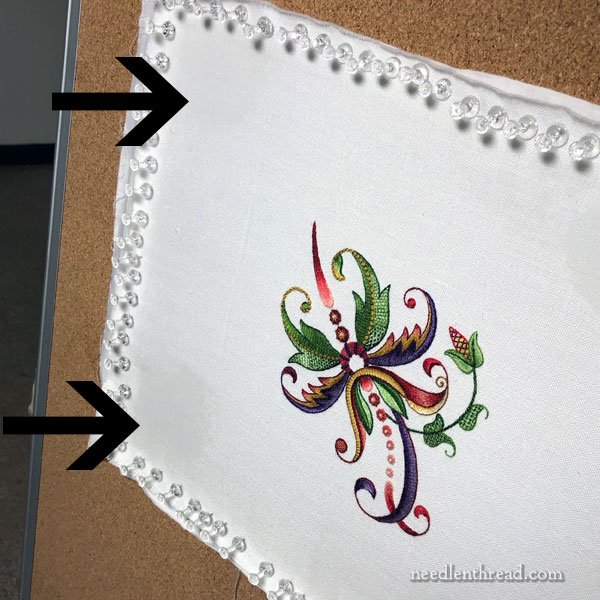
I concentrated a little more water directly on the corner areas of the piece, where it was folded around the foam core board in the first place, since the creases were deeper and more pronounced there.
Then, I left the piece to dry for a couple hours.
Incidentally, there’s nothing quite as wondrous as damp stretching a piece of needlework. When you have noticeable creases in it, and you pin it up and then mist it with water, you can watch the creases disappear right before your eyes. It’s just sooooo satisfying!
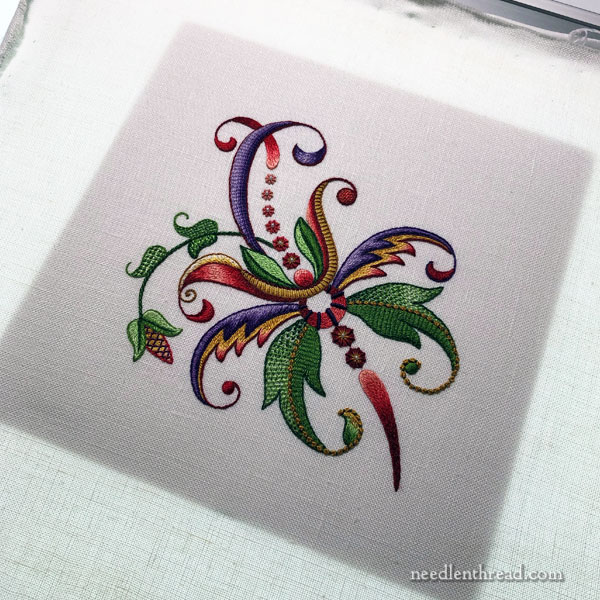
Once the piece was dry and back to perfectly smooth, I removed it from the board.
For Part 2 of this adventure, I used a light pad (you can find one in the resource link below) underneath the rest of my work, to be able to see clearly where my mounting board was in relation to the embroidery. This makes it easier to center things up.
Next time, we’ll look at finishing up this frame job!
It’s time-consuming to frame a piece, and it takes a lot of work that I didn’t initially want to do, but, as usual, I learned a good lesson. Better just do the job myself – if it goes amuck, I only have myself to hold accountable. In the long run, it would have saved me time and money.
Framing Supplies
I’ve added the supplies that I use for framing to my Amazon Recommendations Page, under tools & accessories. If you’re looking for a good spray bottle, I highly recommend the one listed there!
This article contains an affiliate link to my Amazon Recommendations page, which means Needle ‘n Thread receives a small commission for any purchases made through that link, at no extra expense to you. Thanks!







Wow. I would take the piece back when you have it done correctly, show them these images, and demand a refund.
Well, I’d be livid. Livid and disappointed, especially after you were assured that it would be properly stretched. I would also be trotting right back in to discuss who actually thought this was a good example of the framer’s art as well as a refund.
But as usual, you are providing lemonade here in the form of showing us how to do a needlework task correctly and successfully, so for that, many thanks. Looking forward to part 2.
You should send your blog post and the one where you finish the reframing to the framer, along with a request for a refund. That way, they’ll learn how to do it properly. This is appalling.
I agree! You are being very decent by not naming/shaming the framer. I’m sure this wasn’t cheap, and you deserve most of your money back. So disappointing! I do appreciate your posts. I’ve framed a couple of my smaller pieces, and I’ll continue to do so. Thank you for your tips and instructions!
I AM SPEECHLESS! I surely hope that you went back to this butcher and got your money (at least the work part of it) back.
UNBELIEVABLE!
What a absolutely disastrous job by the framer! Maybe the regular framer hadn’t returned to work? If so, you should have been notified.
But, HOORAY for you! Thank you for your expertise and the supply references, too. You’ve inspired me to tackle a botched framing job myself. Looking forward to part 2. Great work, Mary!
What a shock to see all that fabric bunched up. Looking on the bright side, I suppose I’m thankful that you had enough fabric to work with when you were faced with redoing the whole framing job. One of my mom’s pieces was cut to the same side as the foam core board and then masking tape was used to hold it on.
I have a couple of thoughts: why red mat board? I try to keep red anything away from my fabric. 🙂 And secondly, were there any spacers in there to keep the glass off of the fabric? The trouble I have is once I get the glass, some spacers, the material, foam core and some backing, it won’t fit within the frame’s rabbeted notch in the back. Any thoughts on how to find a frame with a deep enough place for everything?
The double matting does the job that spacers would do in this case. The fabric, embroidery, and beads do not touch the glass. It’s actually not too difficult to find pre-made frames that are deep enough to work without spacers. I’ve purchased them off the shelf at places like Hobby Lobby, Michael’s, and the like before. Look in the portrait areas for frames with spacing “built in” between the frame and the glass.
That framing was truly incompetent and outrageous – particularly after your specific questions. You should take your photos and demand a refund.
Darcy
I have to ask: did you talk to the framing shop, tell them about their shoddy workmanship? Did you leave an unfavorable yelp review? I hope they know that you were extremely unhappy and you had to reframe the piece yourself.
That “mounting” was a disgrace. You should demand a partial refund. To save others from such an unprofessional shop, could you at least name the city where the frame shop is? I too have had bad mounting so now I just lace my own to save being disappointed.
I think sharing this email w the framer would be essential info she could use and improve her skills. Not to be mean but as explanation of expectations all needleworkers have for framing our precious handiwork
I assume you’re going to show your photos to the owner of the framing shop? You should be refunded for something more than just the labor costs as the framer must knowingly have done a job that wasn’t up to standard.
Hello – I considered responding to your original post but I looked at your 400+ replies (at the time) and decided no insight of mine was going to add to the body of good advice and suggestions you’d already received. Your update today is fascinating.
You mention that the usual framer was injured and recovering. I suspect the person who did the job was not the experienced framer and you have paid top rates for an amateur stand-in. Perhaps the motivation was not to let you down by doing the job late or not at all but they have let you down by doing such a sub-standard job. I’m sure you’re busy but I think you should alert the framers asap to your dissatisfaction and, when you have a few spare moments (!) present them – by email or in person – with a report including a few photos of the botched job.
I don’t think you would be at all unreasonable if you were to ask for a complete refund. If they are reluctant – along the lines of you should have given them the chance to put the problem right themselves – you can point out that they had already denied there was a problem when you picked up the piece. And finally, eventually I would certainly provide a brief, factual review on whatever review site they appear on. You paid for their expertise. You didn’t get it.
The centering of the piece was a different issue and while I think it looked wrong, they could probably argue it is subjective and looked fine to them. Also they’d probably say you didn’t give them a preferred centre point… all in all, this is probably the smaller skirmish you don’t need to win.
I’m delighted that your efforts to ‘repair’ the botch are bearing fruit and the piece will get the display it deserves. I’m sure you could have done without the extra work and angst, though.
Best wishes, (and ps: love love LOVE your posts – most inspirational projects I’ve seen)
Dear Mary
Oh Mary that is a terrible job of framing, I can’t believe they gave it back to you in such a state. The framing is so bad, no wonder it was bulky and puckered. All that time and money it took to frame it what a waste. I really like your mister I must get one, I hope they sell them in the UK and as you say it is great for damp stretching which I sometimes do. I can’t wait to see part two and watch how you re-framed it and maybe learn how to re-frame myself. Good Luck and thanks for sharing with us your dilemma with the framers.
Regards Anita Simmance
Mary
Many of the comments encourage you to complain bitterly to your framer – but I imagine the message will get back to them!
Had the job been really well done, I’m sure you would have named and given them praise- so they have missed out doubly!!
Judy Qld
Good morning! – For what it is worth, here is my two-cents … If I were you, I would send a copy of these three blogs to the framer. You should be reimbursed for the work you paid for, but that was not done. It bothers me when someone/business gets away with shoddy work. I can’t help but wonder if the expert was still out with an injury and someone else (obviously, inexperienced) took on the task. Perhaps the owner does not even know what was done to your piece. Approach them as you are giving them helpful feedback, vs. a strict criticism. Then, the ball is in their court to make things right, or not. If not, don’t feel bad about leaving them a negative review online to warn others. — I’m really not a very cranky person, but people need to be held accountable…
All I can say is: “Oh, my word”. What a botch job that was. I just spent a day stitching/stretching a miniature painting/textile/embroidered piece 2 days ago. It does take time to get it right…
Oh my! You should definitely demand a refund. And write a yelp review. And show them your blog post. How very unprofessional of this business to do this sort of work after assuring you it would be done appropriately.
Oh, good grief! That was not even an adequate job. Whoever heard of just holding it over and stuffing it in. Sounds like the injured framer was too injured to work or didn’t come back to work on it.
It may be my impression but it looked like the second picture shown even more wrinkling had taken place. Gravity would pull that mess apart.
You will probably be very happy with it when you are finished. At least the frame is made and the matting and glass are usable. I find collecting all the bits for a project takes a lot time, too.
That was my first thought when I saw “red” as well. BAD choice.
Thank you for the update on this dilemma and good on you Mary for re-mounting this piece as it really deserves to be done properly.
After I made my first comment I thought about adding a second saying that the fabric looked more like it was wrapped and not stretched. Luckily for you they didn’t trim out the bulky folds on the back so you had all of the original fabric to be able to re-stretch it, what a relief that must have been.
best regards and kudos for fixing the problem, I’m sure you’re feeling much better about it now ~ Brenda
How extraordinary! Like others here I hope you share your blog post and/or your photos with the framer you spoke to, not necessarily to express your dissatisfaction, but to let her know what was actually done. If it is a decent shop, she may have no idea that the piece was not stretched and handled in the manner she had described to you.
If she does not satisfy you with her response, which to me should include a refund and an apology, I hope you will post a review on their site.
I cannot believe what a shoddy job was done on such a beautiful piece! The shop needs to be notified and you definitely are owed a refund. Maybe a BBB complaint or something so that future customers are not misled as well.
Your pictures say it all….. I haven’t had much framed …. but I have had good luck with a consult with the framer first and selecting mats and frames. I then take the piece home and mount the fabric myself on the foam core that they have cut. I then return it to the shop so they can do the rest. It is an extra step but it seems to work…..if you can find a framer that is willing to do this ….that is. A lesson for us all here I think.
Hi Mary,
I am so glad that you decided to disassemble this shoddy fraud. Many other people have commented in your support, and I’d like to add my two pennyworth.
I think it is ironic that, having used museum quality glass and (presumably) acid-and lignin-free mount boards, (which no doubt were costly) someone thought it was OK to use TAPE on the back.
We hope that our projects will live on for a reasonable time, and take care with the framing materials. Sticking something potentially harmful, which could over the years start to cause rot in the fabric from the reverse is utterly despicable, because YOU would probably never know. It would cause distress to a conservator in the future.
I would at the very least ask for an explanation about the intention to stretch and trim and use a plastic mounting at the back, for what happened to that part of the agreement? Was that part of the invoice of materials?
It’s not my work, Mary, and I am seething. Charging high professional fees for what is clearly an unprofessional make do, is just not on. Is the firm called Messrs Bodgit and Scarper?
All the very best from across the pond. I look forward to episode 2
Elsa
Oh. My. Word. I cannot believe this was done by a professional. Seeing that bulky, poorly folded and taped mess underneath the mat board was jaw-dropping. I agree with other reviewers: definitely send your blog posts to the framer and ask for a refund. Can’t wait for Friday to see how you finished this properly!
I’m (almost) at a loss for words looking at that stuffed fabric loosely held together with tape. Good heavens! Surely that’s not how most pieces would look if we removed the back? Thanks for showing that to us. I just knew it couldn’t have been stretched to have that amount of “waving” in the mounted piece. Mystery solved!
I hope you take these photos to the art gallery and the “framer.”
You should get a complete refund.
Hello miss Corbet,
So glad you were able to fix it!
Perhaps you should email this company a link to the article, so they’ll know how to do it properly in future?… 😉
Oops, sorry, apparently I wasn’t the only one to suggest that lol…
Please, please demand a refund! I’m angry on your behalf. There’s no way this could be considered professional framing. Perhaps–and I’m trying to be very generous here–the owner or manager of the shop has no idea that such shoddy work is being done in house.
I can see why you might not want to mention the framer by name: it’s unkind, etc. BUT you are condemning others to have their precious handwork mishandled and poorly used! I get my works framed and I would be appalled to have them treated as yours have – and I’d certainly want to be warned ahead of time about a bad framer!! Please consider alerting us to their name.
G’day there Mary,
Oh, oh, oh, oh! I can not believe what I have seen. It’s so bad its almost funny, funny oh oh, not funny ha ha . I’m so sorry you’ve had this trouble.
Cheers, Kath
Hi Mary,
I have found that this job is very typical of most framers, even if you pay a lot. They don’t really want to do anything much more than they would do if they were framing something made of paper.
They will NEVER do as good a job as you would yourself. Once you’ve invested all that time doing the stitching, the last thing you want is to have it framed or stretched badly.
I’m glad you decided to do it yourself, Mary!
You really need to talk to the owner. Show them your pictures and the article. You should receive abject apologies plus a free framing of your next project, IF you’d ever trust then again. What they did was amateur and not acceptable.
P.S. If you don’t get a satisfactory response from them, give them a bad review and publish their name here.
That is unbelievable, Mary! What shoddy work for a “professional “. I would not call that professional. You asked if they would trim and stretch the embroidery and they said yes. So they lied. This definitely needs to be taken up with them and a refund for the labor for sure should be refunded. I would not just say lesson learned, they’ll just go on doing this with people and some may just think that’s how it’s done. Consider yourself a champion for the people who get charged a premium and get bilked!
Carol b
Wow, I am speechless looking at that, Mary!
Oh my ! Who hired this person to do the framing.? They know nothing …. just reading for my own knowledge, I have known you do things differently. Framing by RSN standards seems to be the best method I have read about. Handling the backing and the ground differently to get the smoothness that is important. I hope they give your money back.
I agree that you should talk with the framer’s about the substandard work and a refund. Especially since they claimed to be experienced with framing needlework. If their response is unsatisfactory, then you should also give them a bad review to warn others.
Personally, I don’t care for foamcore and I know that it comes in acidfree form, but all foam disintegrates over time.
I would definitely show it to them and express disappointment with regards to the job done, giving them the opportunity to make it right. I would also check on the health or circumstances of the framer who was out for a while. Perhaps that person did not make it back and they put this task on some novice who did not deserve to be saddled with it. It is such a bad job, that would be my guess. All in all, they should give a refund but I believe that a soft, caring heart wins more people over in the long run. I can demand a refund as well as the next person but only like to do so when I have exhausted all other options. Just a thought…
When finished, I would take the piece and all your pictures to the framer, to show them how they SHOULD be framing needlework. In comparing the 2 frame jobs and your disassembly/assembly process, it should be obvious what a shoddy job they did. I would also request a refund. If no refund, post a review with pictures on their website and social media. Even if they refund, I would post that they do NOT know how to frame needlework, but they made good on their work. They are a disaster for stitchers.
Oh no. As others have said, I hope you’re able to get a refund, since they didn’t provide anything close to the service promised you. I am, however, thankful that you are sharing your fix with us! (And I’m glad you had enough fabric to work with to fix it–how awful if they had trimmed it too much and made recentering it impossible!
Oh my! I have taken a framing class and we learned to lace the fabric tight around the foam backing board. I am very lucky my local needlework shop frames, I have been going there for over 25 years….I cannot wait to see your follow up post. Thanks so much for sharing.
Wow, Mary. Just…wow. Did the person who did the intake write down the things you’d asked for? If so….somebody can’t read. That’s the type of “framing” I used to do back in the old days, when I didn’t know anything about needlework. Very disappointing.
I am glad, however, that they didn’t cut anything off because at least you have plenty of edge to use to pin the work out for a re-do. It would have been a shame to have to cut off any of the visible part. I’m looking forward to seeing the rest of the re-frame process. Will you still be able to submit the piece on time?
p.s.- those misting bottles are excellent. I saw them on a sewing blog and ordered a set of 3 different sizes and use them a lot. No soaking, no blobby drops, just a gorgeous, even mist. (I even keep one in the fridge for misting myself on hot days.)
Possibly the worst mounting job ever. I would send photos of their job back to them and ask for a partial refund. Clearly the work was substandard.
Plenty of comments already, but that’s truly astonishing.
I have pieces which look much, much better than that from 40 years ago when all I knew to do was dampen, press, and lace them myself—after a demonstration by our local framer whose costs were too great for me at the time.
By the way, years later my friends and I still use that framer who continues to have the thriving needlework and framing shop she deserves!
Folded and stuck together with . . . masking tape?
In 2nd grade, one art project was embroidery: mushrooms in acrylic knitting yarn (hey, it was 1970!) on burlap. Finishing was fold it around a piece of particle-board and staple it (I think a lot of kids’ Dads helped with that). It was still around a few years ago and I swear that mounting job was better that what your framer came up with!
Holy MOLEY. I really hope you will take the time to go back, show the photos, and get some money back. That is completely unacceptable. I’m so glad you were able to re-do the job properly!
Mary this is horrifying. Why would these people stare you in the face and LIE about their experience with needlework framing?
I should think a full refund of your money is in order, not to mention an apology.
How shameful, how sad.
Oh Mary, this is worse than Boo Hoo—this is N is for Nausea! If this wasn’t such a dire situation, I would be getting a good laugh over this “professional” job. That said, it t seems like you have a teachable moment here—if you care to make it one. IF this small business re-finishes the back without charge & gives you at least a partial refund for using four pieces of masking tape, you might offer to teach them, at no charge, how to properly lace needlework in preparation for framing. You would be helping a fellow small business straighten up & fly right, AND you would be saving countless needlework customers in your area from a similar fate. Just a thought…
I’m angry and upset on your behalf.
Mary,
Oh my!! Folding the material so carelessly and using tape!!! At the very least you should have been notified that there were issues with the framing job. I know better than that.
Judy Kocsis
Yes, absolutely demand a refund!
What a bunch of world class idiots! My suspicion is that the injured framer wasn’t going to be able to do it in time and someone that had never framed anything before decided that they could do it – one of those folks that think they can do anything! As soon as I saw the tape, I wondered if it was masking tape or whatever it was, was it archival tape at least or would it have eventually left glue on the fabric. I’m glad you are taking on the job yourself as I know you will do an excellent job. I would also charge them for the labor costs of the ‘job’ they did since it all had to be redone.
Mary, you should at least get your money back. What they did was awful. They should be held accountable. It might save them doing that to a future customer.
I am so happy you decided to re-do the very sloppy framing job of your beautiful embroidery. Red mat board should never, ever been used in back of the foam core which I hope was archival quality. An acid-free mat board in white should be used in back of the foam core. Thank you for sharing your step-by step restoration of the re-framing process.
Mary – thank you for sharing this mess ! I do hope you return to the shop and share this with the owner – not only should you get your money back [and please don’t be afraid to ask for that !] but the owner will WANT to know what kind of work is going out of their shop in her/his name.
just curious — when you took the piece in did you discuss with the staff what should be done with the extra fabric ? I’m interested in seeing how you handled it in your finished piece
chris in san francisco
Wow. I would be livid if I had paid for that. It’s so frustrating when people and businesses say one things and do the complete opposite. I’m excited to see how it will look when you get done and we see the it framed correct way. I hope you get a refund and the framing place realizes how bad they screwed up but I have also seen where when you show them how they screwed up they agree and then roll their eyes when you leave.
I don’t mean to be rude or provocative here but, I’m confused as to why you used an untested framer for your work when you can, obviously, do such a better job yourself? This is obviously an important piece of work. Was it just time constraints that made you use a “professional” framer initially?
Oh. My. Gosh. TAPE.
Shocking workmanship! And they charged you to do it. It’s dificult to believe they have a good reputation. I have no doubt you will do an excellent job reframing it. Just sorry it’s taking up your precious time.
Mary, That was an appalling job of mounting your embroidery.
Blocking and stretching ones work before moutig and framing is soooo satisfying and also a fun job. Though if you stitch on a frame rather than a hoop, it does not always need to be done, When stitching comes out of a hoop, it is essential. Ann B.
For a piece of needlework that has a significant amount of time invested in it, I like to have the needlework laced on the back of the piece of foamcore or acid free mounting board. I would never trust using just tape to hold it in place, especially where the needlework fabric is lined as I think you said this was. I wouldn’t trust a framer to do the lacing unless they had a lot of experience doing it and then I would want specific agreement on size and how the piece was to be centered. If you do it yourself you can have it the way you want it. Not a lot of framers know how to, or are willing to lace the back. I agree with the comment above that expresses concern about the red backing board.
As soon as I saw your photo of the back of your piece I knew it was a disaster (from many perspectives). As many others have said, I hope you as for the “labor” charges to be refunded. As a visual artist (painter) I’ve seen a lot of framing. That piece of red mat board? That’s a ‘scrap’ piece. On anything that is framed “museum” quality (which we know you ordered) its standard to use black. Sometimes the mat board is black on one side and white on the other (and the white faces the interior). I really hope you get a refund and that the framer you used doesn’t continue this ‘job-type’ on other less informed consumers.
I like to make constructive or amusing comments but seeing the back of the embroidery the only words that come to mind are “HOLY S–T!”
Absolutely shocking—especially after the assurances you were given.
What an amazing mess. Mary, I’m so glad you opened it up to see for yourself what was going on. Do let us know how you handle it with the framers. Other potential customers need to know about their lack of expertise.
I think the centering issue is also a point to emphasize. Like many of the commenters in the other post, I noticed the lack of balance immediately, and as you have pointed out, if they had a concern, they could surely have called to ask how you wanted it centered.
Thank you for posting the information on how you are fixing the piece as well. I find the process very interesting, and appreciate getting the information from someone with your expertise.
I sure hope you’re getting a full refund Mary! That was an awful mess and certainly never, ever framed embroidery before. Thank you for sharing your adventure with us and the proper way to finish embroidery.
That’s amazingly bad. It makes me glad I frame my own work!
I hope you give them a “bye” the next time you have a framing job–and maybe a bad Yelp review! This is totally unprofessional!
I’m glad you showed us what it looked like without editing the wrinkles. I could see that it had been centered on that circle in the middle of the design instead of the outer edges in the photo last week, but not wrinkles. I’d think anyone who knew even a bit about framing needlework would know “that ain’t right!”. I really hope it was a substitute framer that did this. And if it was a substitute, glad they didn’t reach for the sticky board.
In either case, definitely show them this, what you had to do, and request a partial refund. You did get frame and glass, but should not pay for labor. If this was done by original framer, shame on them. If done by a substitute, they need to know more training is needed, or tell them hands off the needlework jobs.
I have had a puckered experience too! But mine was silk and metal goldwork. I worked it in a tight round wooden hoop frame, double layered fabric. I had taken the class at the Royal School so they are really picky about the tightness. I kind of knew that when I took it out of the hoop frame I doubted whether it would stay nice and smooth. It was done on silk fabric. So the question is, I can’t mist the silk to get it straight, can I? It came back from the framers with puckers between the stitched parts, and I tried disassembling the piece and reassembling it, (it was laced) but could not get the puckers out. Any suggestions?
Hi, Lois –
If you worked it in a hoop, you’d most likely want to damp stretch and block it, anyway, because that’s pretty much the only way you’ll get a hoop ring out. Perhaps the hoop ring is not visible in the frame job, though.
Normally, though, silk ground fabric and goldwork are a bit tricky. You don’t normally want to get real metal threads wet, and if your spray bottle produces a non-uniform spray, you could end up with spotting on the silk. That said, I’ve damp stretched goldwork on silk successfully. You can do it from the back – you can pin it with the goldwork facing your cork board and mist the back of the work – pinning both layers of fabric.
Now, there’s a difference between the fabric rippling (like you see in my project) and “puckering.” The rippling in my project is due to a lack of tension on the fabric. There was no tension on the fabric at all when it was mounted on the foam core board, so it’s just sort of flopping off of the backing board. But there’s no actual “puckering” around my stitches, which it sounds like you’re describing.
“Puckering” is a different matter. If you have puckering around your embroidery, even after lacing the embroidery on a mounting board, this has to do with your stitching tension when you originally worked the design. Your teacher would normally notice that your stitching tension was perhaps too tight as you were working and normally would have you modify the amount of tension you were putting on your stitches. This is the advantage of a person-to-person class, so you can get immediate feedback on things like that. If it wasn’t noticed during the class and the whole piece was tightly stitched, you’re most likely not going to be able to do anything about puckers around the stitched areas. The lacing can help pull it out a little bit, but there is a chance you won’t be able to get rid of all of it.
Still, you might try damp stretching to see if it helps eliminate some of the puckering. With goldwork, I’d pin the work face down to a board and lightly mist the back of the fabrics and leave it to dry. It might relax some of the puckering. It’s not my favorite thing to have to do, when silk and metal threads are involved – that’s why it makes more sense (to me, anyway) to always work any kind of embroidery on a silk ground or involving metal threads on stretcher bar frames or on a slate frame or something similar, rather than in a hoop, and to be very aware of stitching tension while embroidering. Hopefully, your instructor will guide you further on that point, if you are still taking classes.
Good grief Mary! I couldn’t believe my eyes when I saw this! I’m utterly appalled that any professional framer would consider letting a job like this out of their workshop! It’s the cynicism of their assumption that you wouldn’t notice, or that if you did they could bat it away with such an offhand response. And that you wouldn’t know the difference between good and shoddy work if you opened it up … although they’re clearly relying on the probability of ‘once it’s stuck down no one will be able to find out’. Too bad for them you are an experienced needleworker and can prove your point! I loved seeing your repair job you have done so far, what a relief to see the rumples all smoothed out.
Just wanted to drop you a line to thank you for this VERY DETAILED “reconstruction.” I clung to every description and picture. I’m going to go to to a framer with questions you’ve provided.
Thanks again!
I have an oval sampler in a frame which belonged to my mother in law. The frame and backing is in need of repair. Can you recommend anyone suitable anywhere near Reading.
Thanks